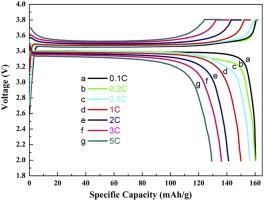Synthesis,characterization and electrochemical performances of LiFePO4/graphene cathode material for high power lithium-ion batteries |
| |
| Affiliation: | 1. Institute of Physics, PAS, 02-668 Warsaw, Al. Lotników 32/46, Poland;2. Donetsk Institute for Physics and Engineering Named After O.O. Galkin, NАSU, 83114 Donetsk, R. Luxembourg Str. 72, Ukraine;3. Ioffe Physico-Technical Institute RAS, 194021 St. Petersburg, Russia;1. College of Mechanical and Electric Engineering, Beijing University of Chemical Technology, Beijing, 100029, China;2. College of Materials Science and Engineering, Beijing University of Chemical Technology, Beijing, 100029, China;3. College of Materials Science and Engineering, Shandong University of Science and Technology, Shandong Province, 266590, China;1. State Key Laboratory of Powder Metallurgy, Central South University, Changsha 410083, China;2. School of Materials Science and Engineering, China University of Mining and Technology, Xuzhou 221116, China;1. Department of Chemistry, National Tsing Hua University, Hsinchu 30013, Taiwan;2. Department of Chemistry, Vietnam National University, Hanoi 10000, Viet Nam |
| |
| Abstract: | 
LiFePO4/graphene (LiFePO4/G) cathode with exciting electrochemical performance was successfully synthesized by liquid phase method. LiFePO4 nanoparticles wrapped with multi-layered grapheme can be fabricated in a short time. This method did not need external heating source. Heat generated by chemical reaction conduct the process and removed the solvent simultaneously. The LiFePO4/G were analyzed by X-ray diffraction (XRD) analysis, scanning electron microscope (SEM), transmission electron microscopy (TEM), magnetic properties analysis and electrochemical performance tests. The LiFePO4/G delivered a capacity of 160 mAh g−1 at 0.1C and could tolerate various dis-charge currents with a capacity retention rate of 99.8%, 99.2%, 99.0%, 98.6%, 97.3% and 95.0% after stepwise under 5C, 10C, 15C, 20C, 25C and 30C, respectively. |
| |
| Keywords: | Liquid phase method Graphene Lithium-ion batteries |
| 本文献已被 ScienceDirect 等数据库收录! |
|

